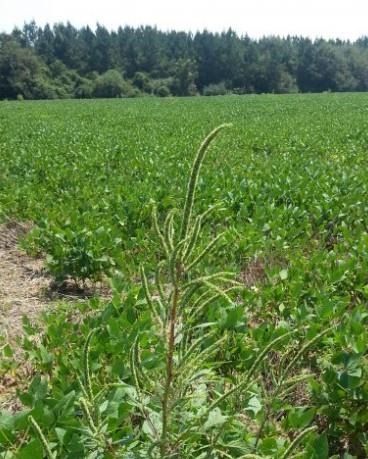Glyphosate is a Group 9 herbicide. Group codes help producers select product rotations using other modes of action to prevent resistance.

Herbicide resistant palmer amaranth plant in a glyphosate resistant soybean field. Most plants were controlled but not this one. Credit: UF/IFAS Archive.
Integrated pest management is an important concept in helping to avoid the buildup of resistance. Whenever possible, it encourages the use of other management strategies to prevent or reduce pest problems. The various methods of control include:
- Biological control, which uses natural predators and pathogens, such as releasing predatory or parasitic insects to control other insects.
- Cultural control, such as planting at the proper time, using resistant cultivars, rotating crops, or managing irrigation to avoid or reduce pest problems. An early planting of peanuts, for example, can help avoid some fungal leaf spot problems which spread rapidly in warm, wet weather.
- Mechanical control, or physically controlling or excluding pests. Trapping pests or using a fence to exclude them from an area are examples.
- Chemical control with pesticides is sometimes the only available option, or the only one that is feasible from a time or economic standpoint.
An important first step to managing any pest and in deciding how to manage it is to learn all you are able about it. Keep an eye on updates from specialists in your area to determine what problems are likely to show up. Weather conditions can seriously skew the numbers and types of pests we see in any given year, and sometimes outbreaks can be predicted.
In North Florida, keep an eye on the articles written by our Extension agents and specialists on Panhandle Agriculture e-News. You can find information on specific pests and control methods for those pests in our EDIS publications. For information on pesticide resistance, the EPA has more information, which includes links to resources on pesticide mode-of-action groups. As always, our county Extension agents are available as well.
Source : ufl.edu